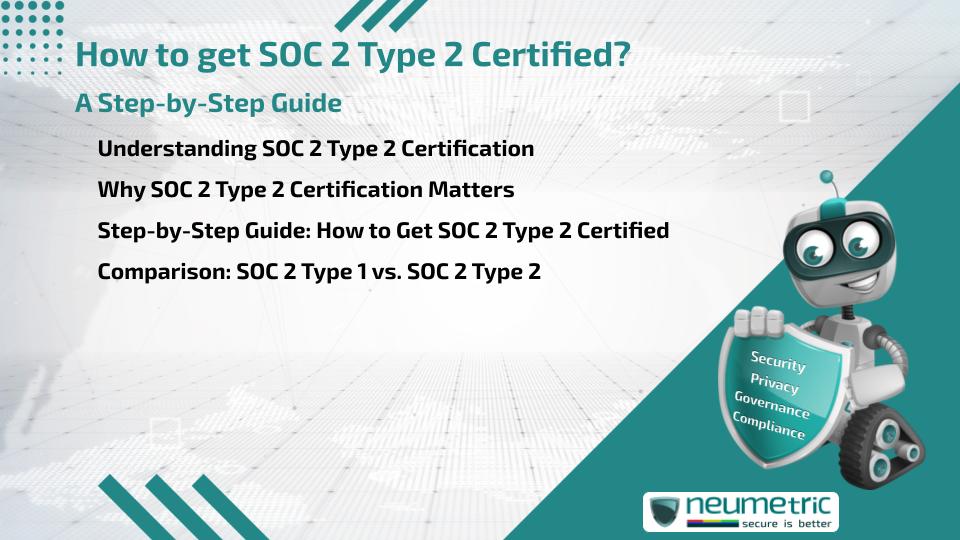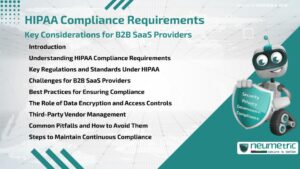Table of Contents
ToggleUnderstanding SOC 2 Type 2 Certification
SOC 2 Type 2 certification is a vital credential for businesses handling sensitive customer data. Developed by the American Institute of Certified Public Accountants [AICPA], it validates that a company maintains robust security controls over time. Understanding how to get SOC 2 Type 2 certified is essential for businesses looking to enhance trust & compliance.
Why SOC 2 Type 2 Certification Matters
SOC 2 Type 2 certification demonstrates a company’s long-term commitment to data security. Unlike SOC 2 Type 1, which evaluates controls at a single point in time, SOC 2 Type 2 assesses their effectiveness over an extended period. This makes it more valuable for clients seeking assurance that their data is consistently protected.
Key Benefits of SOC 2 Type 2 Certification
Key Benefits of SOC 2 Type 2 Certification
- Strengthens customer trust & confidence
- Provides a competitive advantage in B2B transactions
- Helps meet regulatory & compliance requirements
- Reduces the risk of data breaches & security incidents
- Enhances operational transparency
Step-by-Step Guide: How to Get SOC 2 Type 2 Certified
Step 1: Define Your Scope & Objectives
Start by determining the scope of your SOC 2 Type 2 audit. Identify which systems, processes & services will be covered. Consider factors such as:
- Data types & storage methods
- Compliance requirements
- Client expectations
Step 2: Select a Trust Service Criteria [TSC]
SOC 2 audits are based on five Trust Service Criteria:
- Security (Mandatory)
- Availability
- Processing Integrity
- Confidentiality
- Privacy
Choose the criteria most relevant to your business needs.
Step 3: Conduct a Readiness Assessment
A readiness assessment helps identify gaps in your security controls before the formal audit. This assessment includes:
- Reviewing policies & procedures
- Assessing security controls
- Identifying weaknesses & areas for improvement
Step 4: Implement Necessary Controls
Address the gaps found during the readiness assessment. This may include:
- Enhancing security policies
- Strengthening access controls
- Improving incident response plans
- Implementing encryption protocols
Step 5: Conduct Internal Testing & Monitoring
Before the formal audit, conduct internal tests to ensure all controls function effectively. Use:
- Regular security audits
- Employee training sessions
- Automated monitoring tools
Step 6: Hire an Independent Auditor
SOC 2 audits must be conducted by an independent Certified Public Accountant [CPA] firm. Select a reputable firm with experience in SOC 2 assessments.
Step 7: Undergo the SOC 2 Type 2 Audit
The auditor will evaluate your controls over a period (typically 3 to 12 months). They will assess:
- Effectiveness of security measures
- Compliance with Trust Service Criteria
- Any security incidents or breaches
Step 8: Review the Audit Report
Once the audit is complete, the CPA firm will issue a SOC 2 Type 2 report detailing:
- Audit scope & findings
- Effectiveness of security controls
- Areas needing improvement (if any)
Step 9: Address Any Identified Issues
If the audit report highlights deficiencies, create an action plan to address them. Implement necessary changes & improve security controls.
Step 10: Maintain Compliance & Continuous Monitoring
SOC 2 Type 2 certification is not a one-time achievement. Maintain compliance through:
- Regular security updates
- Ongoing monitoring
- Annual audits
Comparison: SOC 2 Type 1 vs. SOC 2 Type 2
| Feature | SOC 2 Type 1 | SOC 2 Type 2 |
| Assessment Period | Single point in time | Over 3 to 12 months |
| Focus | Control design & implementation | Operational effectiveness |
| Value | Initial compliance check | Long-term security validation |
Conclusion
Understanding how to get SOC 2 Type 2 certified is crucial for businesses handling sensitive data. By following a structured approach, companies can ensure compliance, strengthen security & gain a competitive advantage. Continuous monitoring & improvement are key to maintaining certification & safeguarding client trust.
Takeaways
- SOC 2 Type 2 certification verifies security controls over time.
- A readiness assessment helps identify gaps before the audit.
- Hiring an experienced CPA firm ensures a smooth audit process.
- Continuous monitoring & compliance maintenance are essential.
FAQ
What is the difference between SOC 2 Type 1 & SOC 2 Type 2?
SOC 2 Type 1 assesses controls at a specific point in time, while SOC 2 Type 2 evaluates their effectiveness over an extended period.
Who needs SOC 2 Type 2 certification?
Any business that stores or processes customer data, especially SaaS companies & cloud service providers, benefits from SOC 2 Type 2 certification.
How long does it take to get SOC 2 Type 2 certified?
The process typically takes between 6 & 12 months, depending on an organisation’s preparedness & the audit duration.
How much does SOC 2 Type 2 certification cost?
Costs vary based on company size, audit scope & readiness. It generally ranges from $20,000 to $100,000.
Can a company fail a SOC 2 Type 2 audit?
Yes, if security controls are ineffective or non-compliant, the audit may result in a qualified or adverse report.
How often should a company undergo a SOC 2 Type 2 audit?
Most companies renew their SOC 2 Type 2 certification annually to maintain compliance.
What are the penalties for not having SOC 2 Type 2 certification?
While there are no legal penalties, lacking SOC 2 Type 2 certification can result in lost business opportunities & decreased customer trust.





